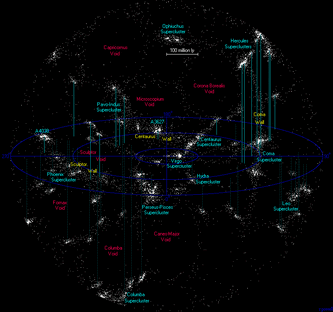In physical cosmology, filaments are the largest known structures in the universe, thread-like structures with a typical length of 50 to 80 megaparsecs h-1 that form the boundaries between large voids in the universe. Filaments consist of gravitationally-bound galaxies; parts where a large number of galaxies are very close to each other are called superclusters. Discoveries about "hyperclusters" (clusters of superclusters) started in the 1980s. In 1987 astronomer R.Brent Tully of the University of Hawaii’s Institute of Astronomy identified what he called the Pisces-Cetus SuperCluster Complex. In 1989 the CfA2 Great Wall was discovered, followed by the Sloan Great Wall in 2003. In 2006, scientists announced the discovery of three filaments aligned to form the largest structure known to humankind, composed of densely-packed galaxies and enormous blobs of gas known as Lyman alpha blobs.
List[]
Filament subtype of filaments have roughly similar major and minor axes in cross-section, along the lengthwise axis.
Filaments of Galaxies
| Filament | Date | Mean Distance | Dimension | Notes |
|---|---|---|---|---|
| Coma Filament | The Coma Supercluster lies within the Coma Filament. It forms part of the CfA2 Great Wall. | |||
| Perseus-Pegasus Filament | 1985 | Connected to the Pisces-Cetus Supercluster, with the Perseus-Pegasus Filament being a member of the filament. | ||
| Ursa Major Filament | Connected to the CfA Homunculus, a portion of the filament forms a portion of the "leg" of the Homunculus. | |||
| Lynx-Ursa Major Filament (LUM Filament) | 1999 | from 2000km/s to 8000km/s inredshift space | Connected to and separate from the Lynx-Ursa Major Supercluster. | |
| z=2.38 filament around protocluster CIG J2143-4423 | 2004 | z=2.38 | 110Mpc | A filament the length of the Great Wall was discovered in 2004. As of 2008, it was still the largest structure beyond redshift 2. |
The Galaxy wall subtype of filaments have a significantly greater major axis than minor axis in cross-section, along the lengthwise axis.
| Wall | Date | Mean Distance | Dimension | Notes |
|---|---|---|---|---|
| CfA2 Great Wall (Coma Wall,Great Wall, Northern Great Wall,Great Northern Wall, CfA Great Wall) | 1989 | z=0.03058 | 251Mpc long:750 Mly long 250 Mly wide 20 Mly thick |
This was the first super-large large-scale structure or pseudo-structure in the universe to be discovered. It is also the second largest. The CfA Homunculus lies at the heart of the Great Wall, and the Coma Supercluster forms most of the homunculus structure. The Coma Cluster lies at the core. |
| Sloan Great Wall (SDSS Great Wall) | 2005 | z=0.07804 | 433Mpc long | This is the largest known structure or pseudo-structure in the universe discovered so far. |
| Sculptor Wall (Southern Great Wall, Great Southern Wall, Southern Wall) | 8000km/s long 5000km/s wide 1000km/s deep(in redshift spacedimensions) |
The Sculptor Wall is "parallel" to the Fornax Wall and "perpendicular" to the Grus Wall. | ||
| Grus Wall | The Grus Wall is "perpendicular" to the Fornax and Sculptor Walls. | |||
| Fornax Wall | The Fornax Cluster is part of this wall. The wall is "parallel" to the Sculptor Wall and "perpendicular" to the Grus Wall. |
- A Centaurus Wall or Centaurus Great Wall has been proposed, and would have the Fornax Wall as a portion of it, visually created by the Zone of Avoidance. It would also include the Centaurus Supercluster and the Local Supercluster, (this would then be the Local Wall or Local Great Wall)
- A wall has been proposed to be the physical embodiment of the Great Attractor, with the Norma Cluster as part of this wall. This wall is also referred to as the Great Attractor Wall or Norma Wall.
- A wall has been proposed, in 2000, to lie at z=1.47 in the vicinity of radio galaxy B3 0003+387.
- A wall has been proposed, in 2000, to lie at z=0.559 in the northern Hubble Deep Field (HDF North).

The Universe within 500 million Light Years, showing the nearest galaxy walls